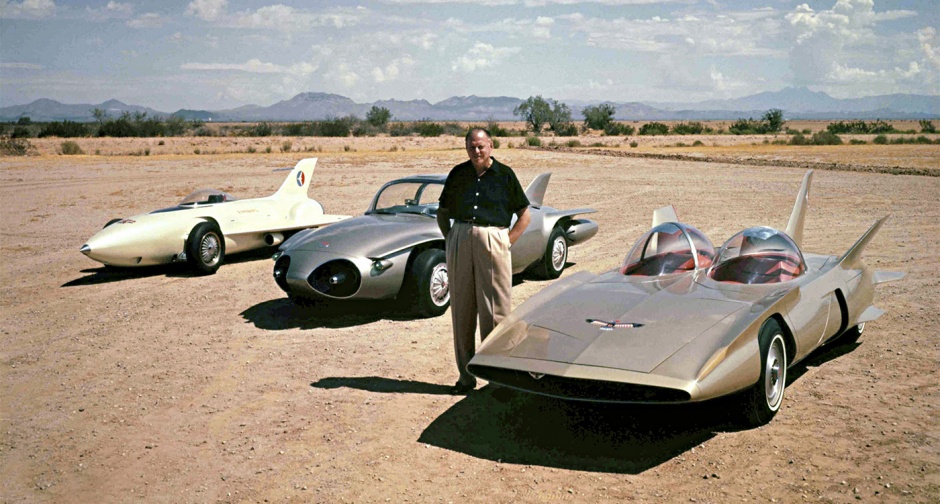
Harley Earl of General Motors called them “Dream Cars” what he invented was the idea of the “concept car” between 1950-1959. He designed futuristic forward thinking innovations. GM and Harvey Earl predicted auto pilot, navigation, computers, cameras, video display, retractable headlights, cup holders, four wheel disc brakes, turbine motors, and numerous other innovations in the 1950’s. Here is the true story.
1953 Firebird I Concept Car
The 1954 XP-21 Firebird I was the first gas turbine automobile ever to be built and tested in the United States. Designed strictly as an engineering and styling exercise, Firebird I was intended to determine whether the gas turbine could be used as an efficient and economical powerplant for future vehicles.
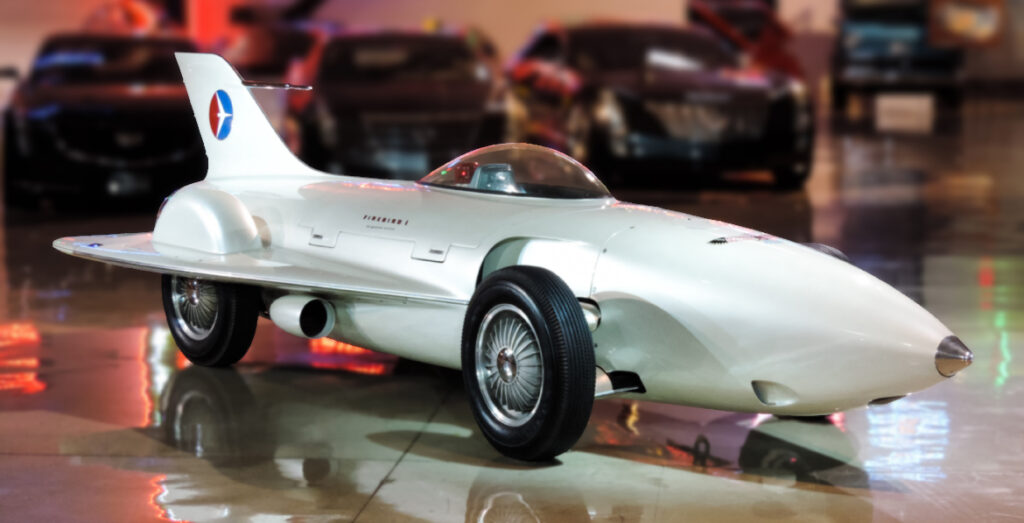
The General Motors Firebird concept cars of the 1950’s were prototype cars that General Motors engineered and built for the 1953, 1956, and 1959 for the Motorama auto shows. The car designer, Harley Earl, took his inspiration from the innovations in fighter aircraft design at the time. General Motors never intended the cars for production, but rather to showcase the extremes in technology and design that the company was able to achieve.
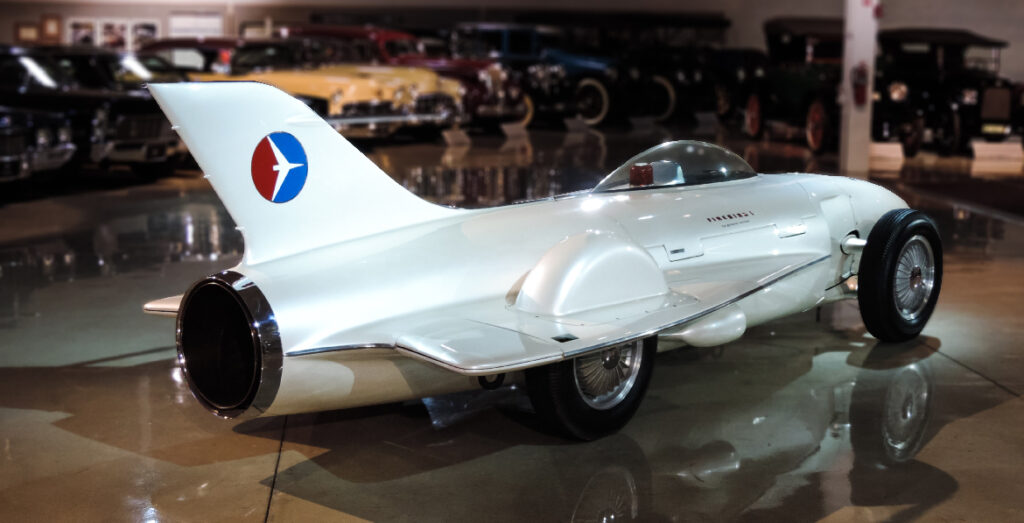
By 1953, the GM research team had produced the Firebird XP-21, later referred to as the Firebird I, which was essentially a jet airplane on wheels. It was the first gas turbine-powered car tested in the United States. The design is entirely impractical, with a bubble canopy over a single-seat cockpit, a bullet-shaped fuselage made entirely of fiberglass, short wings, and a vertical tail fin. It has a 370 hp (280 kW) Whirlfire Turbo Power gas turbine engine, which has two speeds, and expels jet exhaust at some 1,250 °F (677 °C). The entire weight of the car is 2,500 lb (1,134 kg), with a 100-inch wheelbase.
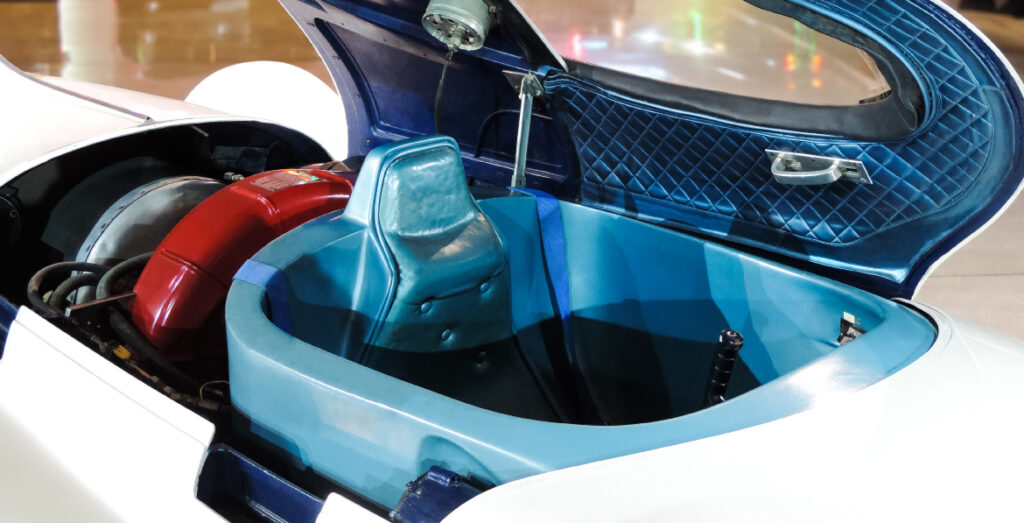
At first, Conklin was the only person qualified to drive the Firebird I, and he tested it up to 100 mph (160 km/h), but upon shifting into second gear the tires lost traction under the extreme engine torque and he immediately slowed down for fear of crashing. Race car driver Mauri Rose later test drove the car at the Indianapolis Speedway. GM never actually intended to test the power or speed potential of the gas turbine, but merely the practical feasibility of its use. The braking system differs from standard drum systems, in that the drums are on the outside of the wheels to facilitate fast cooling and the wings actually have aircraft-style flaps for slowing from high speed.
Firebird I: Skateboard-like design chassis and power train.
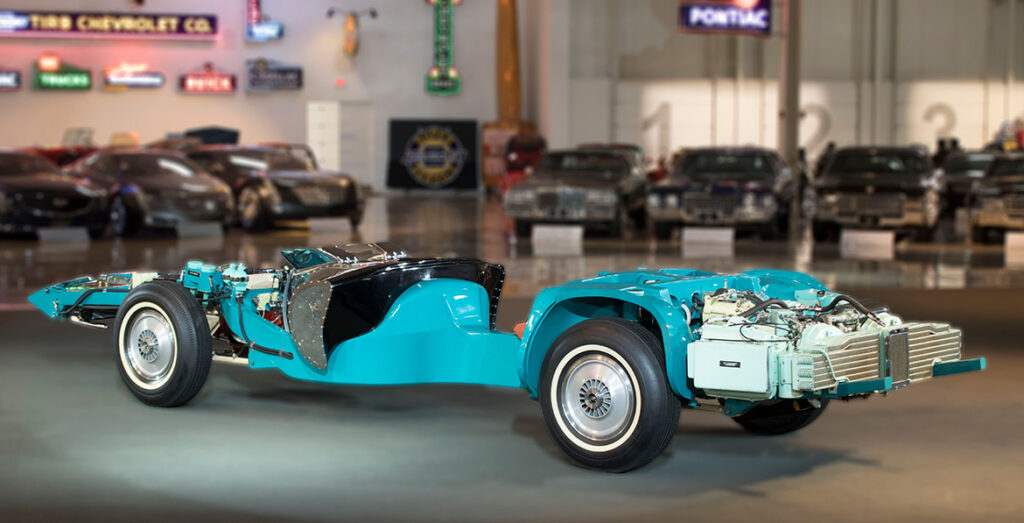
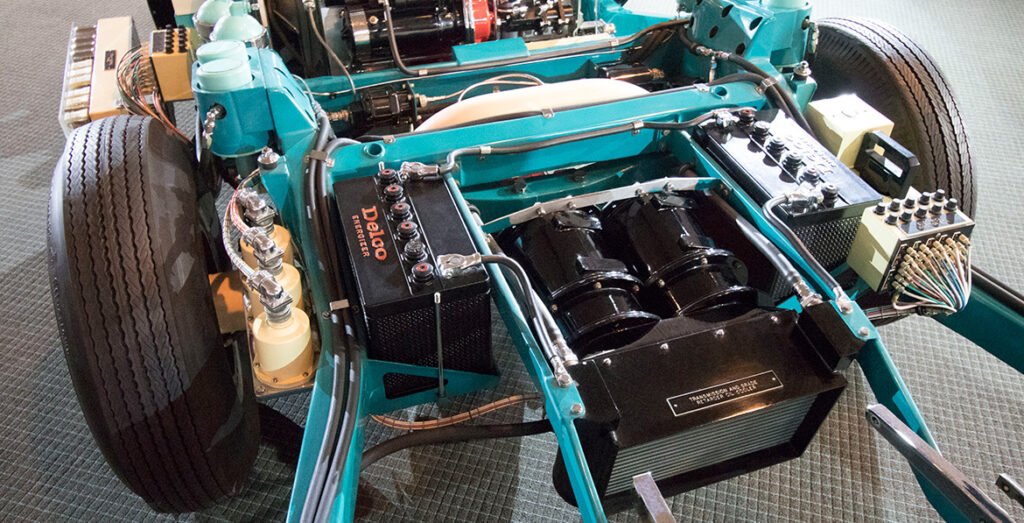
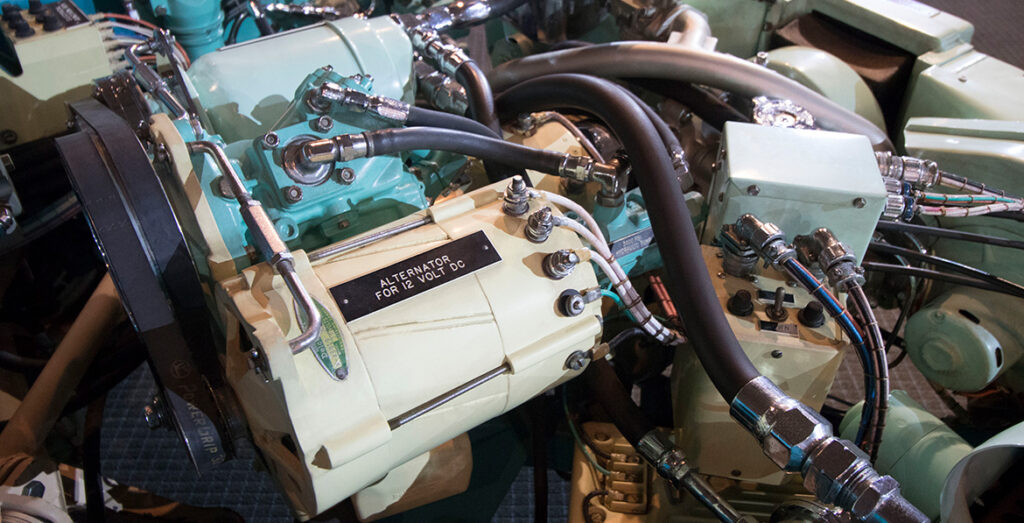
1953 Firebird I Concept Car with body panel removed exposing chassis and electronics.
The 1953 XP-21 Firebird 1 was the first gas turbine automobile ever to be built and tested in the United States. Designed strictly as an engineering and styling exercise, Firebird 1 was intended to determine whether the gas turbine could be used as an efficient and economical powerplant for future vehicles.
The idea for Firebird I originated with Harley J. Earl, the legendary GM Styling Vice President, who also designed the car’s aircraft-inspired fiberglass-reinforced plastic body. The engine, termed “Whirlfire Turbo-Power,” was developed under the direction of Charles L. McCuen, then general manager of GM Research Laboratories Division.
Unlike a jet airplane, which develops thrust through the action of exhaust gas through a tailcone, the Whirlfire Turbo-Power engine propelled the Firebird 1 through a power turbine acting on the rear wheels via a transmission. The engine was capable of 370 hp at a power turbine speed of 13,000 rpm.
The idea for Firebird I originated with Harley J. Earl, the legendary GM Styling Vice President, who also designed the car’s aircraft-inspired fiberglass-reinforced plastic body. The engine, termed “Whirlfire Turbo-Power,” was developed under the direction of Charles L. McCuen, then general manager of GM Research Laboratories Division.
Unlike a jet airplane, which develops thrust through the action of exhaust gas through a tailcone, the Whirlfire Turbo-Power engine propelled the Firebird I through a power turbine acting on the rear wheels via a transmission. The engine was capable of 370 horsepower at a power turbine speed of 13,000 rpm.
Every surface of the vehicle was refined in the California Institute of Technology wind tunnel, one of the first examples of the application of aerodynamic theories to automobile vehicle design. The negative angle of attack of the wings and the 6-square-foot area of the tail fin were all optimized through this ground-breaking work.
Wheelbase: 100.0 in (254.00 cm)
Weight: 2800.00 lbs (1,270.06 kg)
Engine: Single Stage, Axial Flow Turbine, 370 horsepower @ 26,000 rpm
Harley J. Earl Daytona 500 Trophy
The Harley J. Earl Trophy is named after General Motors car designer Harley Earl. Earl, the second commissioner of NASCAR, was the designer of the Chevrolet Corvette; his Firebird I concept car provides the basis of the automobile that sits atop the trophy; The car is often misidentified as Sir Malcolm Campbell‘s “Blue Bird” land speed record car. Earl was a friend of NASCAR founder Bill France, Sr., who named the trophy after him as a sign of respect.
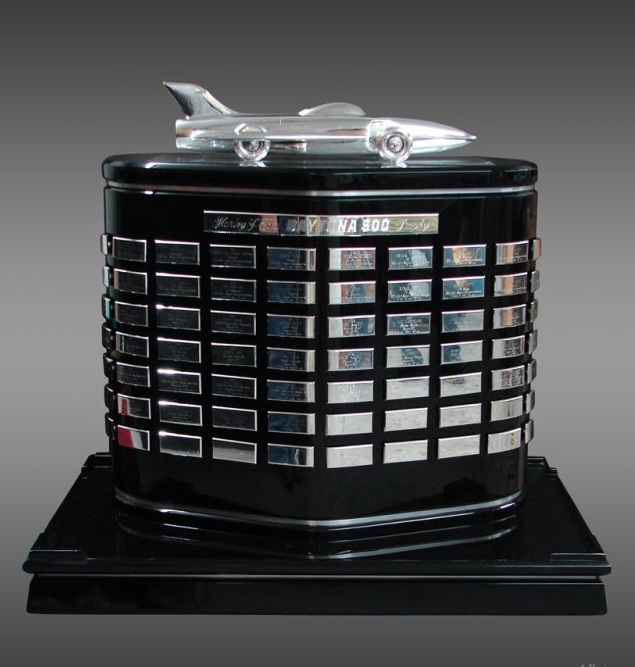
A miniature version of the Firebird I crowns the Harley J. Earl Trophy, given annually to every winner of the Daytona 500.
1956 Firebird II Concept Car
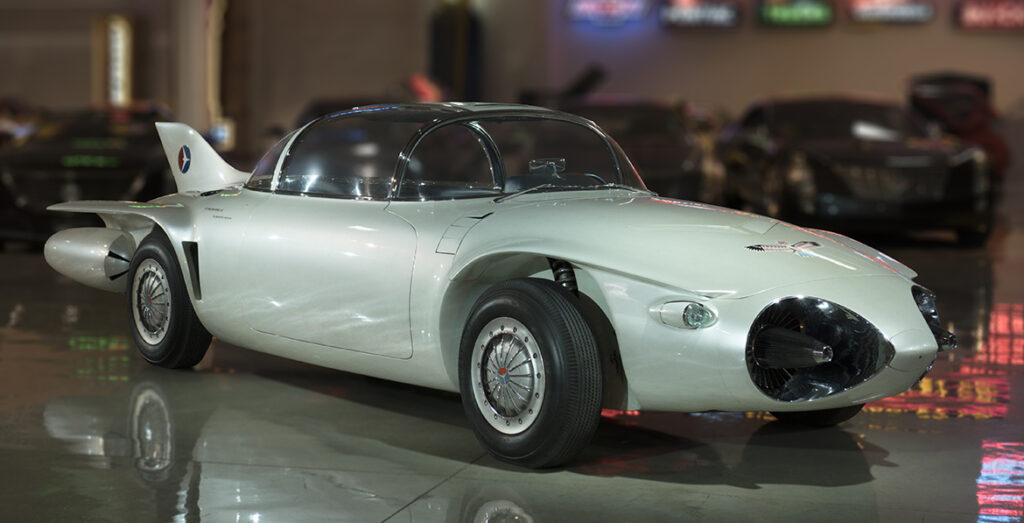
The second concept car, the Firebird II of 1956, was a more practical design: a four-seat, family car. It is a low and wide design with two large air intakes at the front, a high bubble canopy top, and a vertical tail fin. Its exterior bodywork is made entirely of titanium (which turned out to be hard to make). The engine output is 200 hp (150 kW). To solve its exhaust heat problem, the car feeds the exhaust through a regenerative system, which allows the entire engine to operate cooler around 1,000 °F (538 °C), and also powers the accessories. Kerosene was the most common fuel used. Another innovation on the car is the first use of disc brakes on all four wheels, along with a fully independent suspension. It also featured a sophisticated guidance system intended for use with “the highway of the future,” where an electrical wire embedded in the roadway would send signals that would help guide future cars and avoid accidents.
Specifications
- GM internal code: XP-43
- Wheelbase: 120 in (3,048 mm)[6]
- Length; 234.7 in (5,961 mm)[6]
- Ground clearance: 5.5 in (140 mm)
The four-passenger Firebird II was characterized by innovations like a titanium body, a regenerative gas turbine, all-wheel independent suspension with automatic load-leveling, power disc brakes, alternator, magnetic ignition key, electric gear selection, and individually-controlled air conditioning.
The Firebird II had forward thinking features such as retractable head-lamps with rectangular lenses, pivoting directional signals, air flaps on the hood to vent engine and deflect bugs, a magnetic door key and a luggage compartment raised and lowered by remote control.
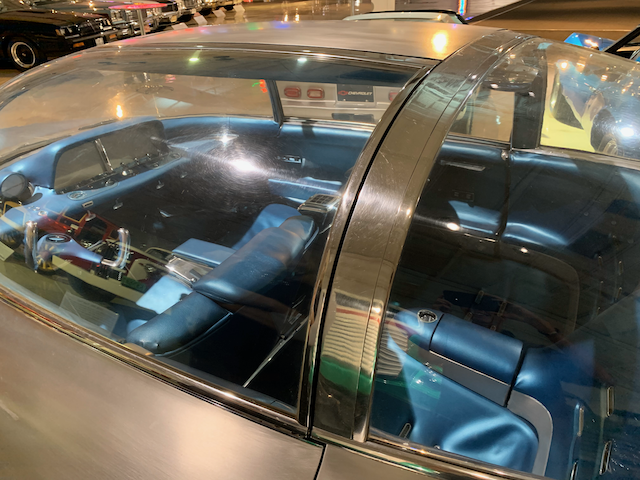
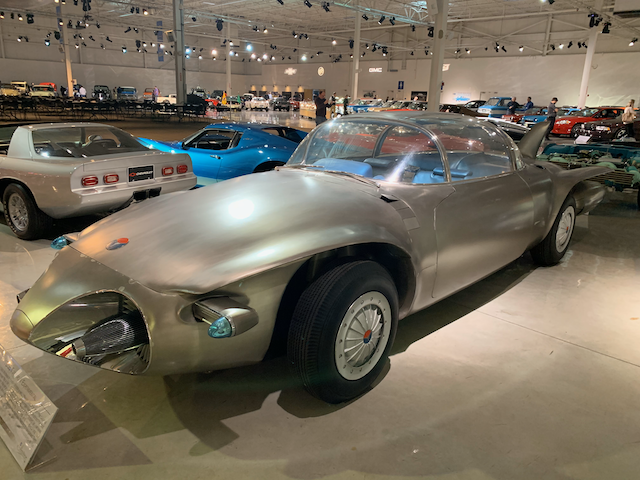
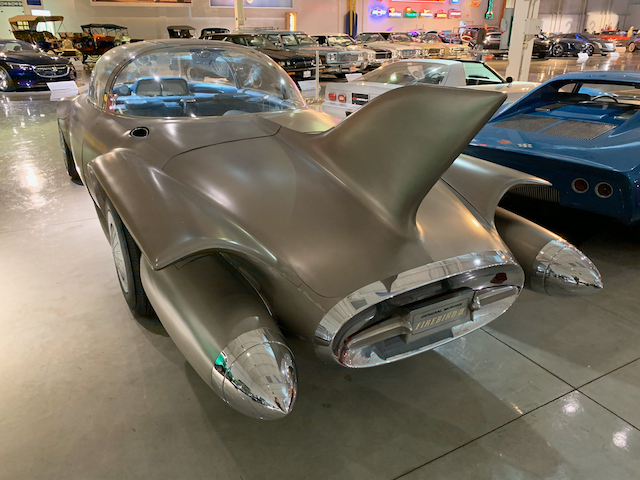
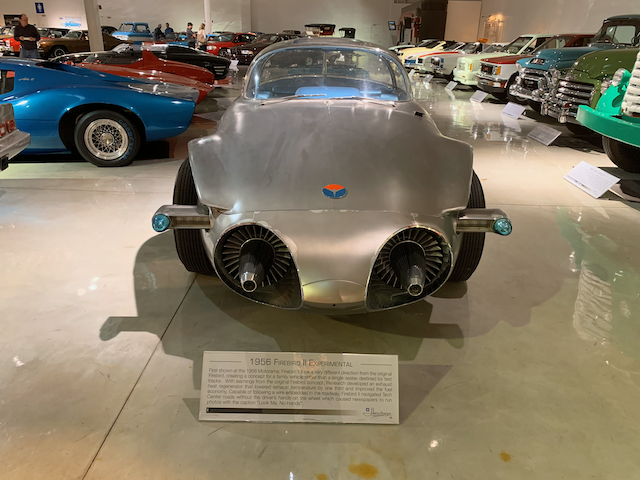
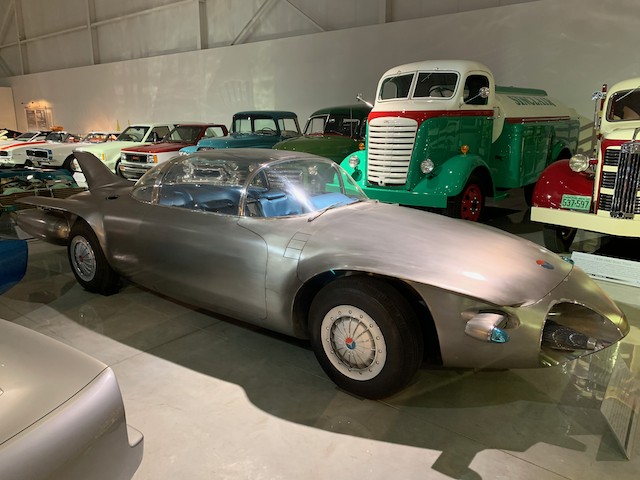
I had the distinct opportunity to see the 1956 Firebird II concept car at the GM Heritage Center in Sterling Heights, Michigan. Here are some of my photo’s.
Some interesting interior features included a beverage cooler and outlet, retractable seat belts, reclining airplane-type seats, electronic adjustable headrests, ventilated seat cushions and a picnic table. The Firebird II also included a viewing screen for engine information, communication with the traffic “tower” and TV programs. A second screen replaced the rear-view mirror. A sophisticated guidance system or electronic auto-control was intended to be used with ‘the highway of the future.’ It utilized an electric wire, embedded into a roadway, to send signals to guide future cars and avoid accidents. This concept is the forerunner to self-driving cars, first seen by Motorama attendees 65 years ago.
The 1956 Motorama movie [1] projected a future that contrasted with the (1956) present. In that present, a nuclear family of hot and perspiring convertible occupants are attempting to travel to the beach—but they are stuck, immobile, trapped in an insufferable freeway traffic jam. In a flashforward to the future, they are cruising at high speed in air conditioned comfort along an automated freeway (with no other vehicles to be seen) in their turbine-powered Firebird. The movie’s concept (now more than fifty years old) was that this future was not unreasonably remote, and General Motors would provide it—and yet it is consistent with current projections (2008) for future automotive travel using electronic vehicle control and improved highway infrastructure.
1959 Firebird III Concept Car
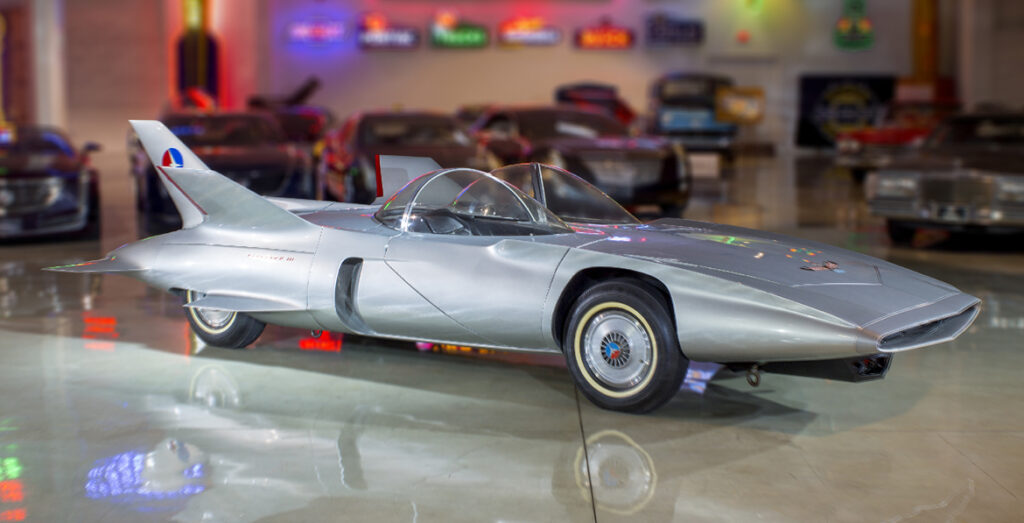
GM built the third design, the Firebird III, in 1958 and debuted it at Motorama in 1959. It is another extravagant concept with a fiberglass body and no fewer than seven short wings and tail fins (which were tested extensively in a wind tunnel). It is a two-seater powered by a 225 hp (168 kW) Whirlfire GT-305 gas turbine engine, with a two-cylinder 10 hp (7.5 kW) gasoline engine to run all the accessories. Its exterior design features a double-bubble canopy and technical advancements to make it more practical, such as cruise control, anti-lock brakes, and air conditioning. It also featured “Space-Age” innovations, such as special air drag brakes like those found on aircraft, which emerged from flat panels in the bodywork of the car to slow it from high speeds; an “ultra-sonic” key that signaled the doors to open; an automated guidance system to help avoid accidents; and “no hold” steering. The driver controlled the steering with a joystick positioned between the two seats.[7] This gave the car a more futuristic feel and simulated the experience of flying a plane.
Specifications
- GM internal code: XP-73
- Wheelbase: 119 in (3,023 mm)[8]
- Length: 248.2 in (6,304 mm)
- Height: 44.8 in (1,138 mm) (canopy top)[8]
- Ground clearance: 5.3 in (135 mm)
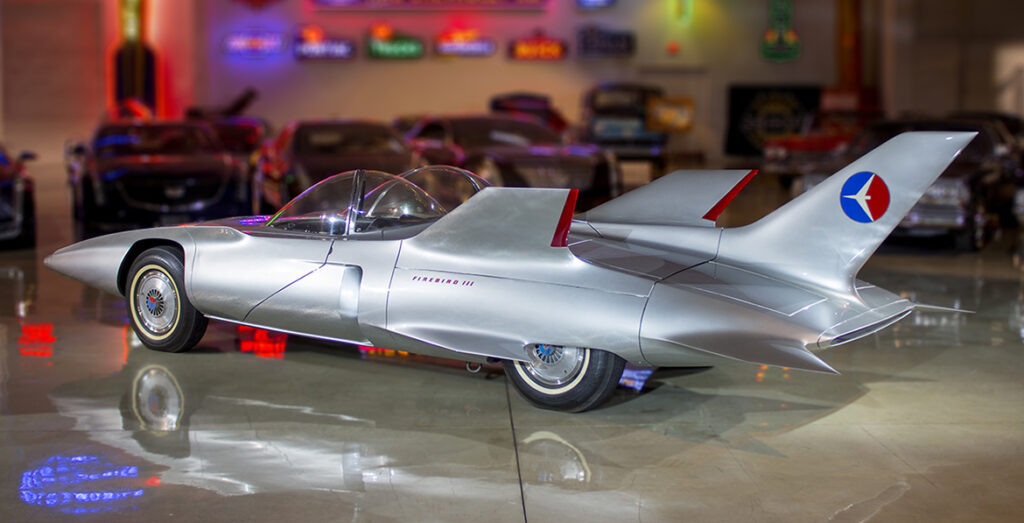
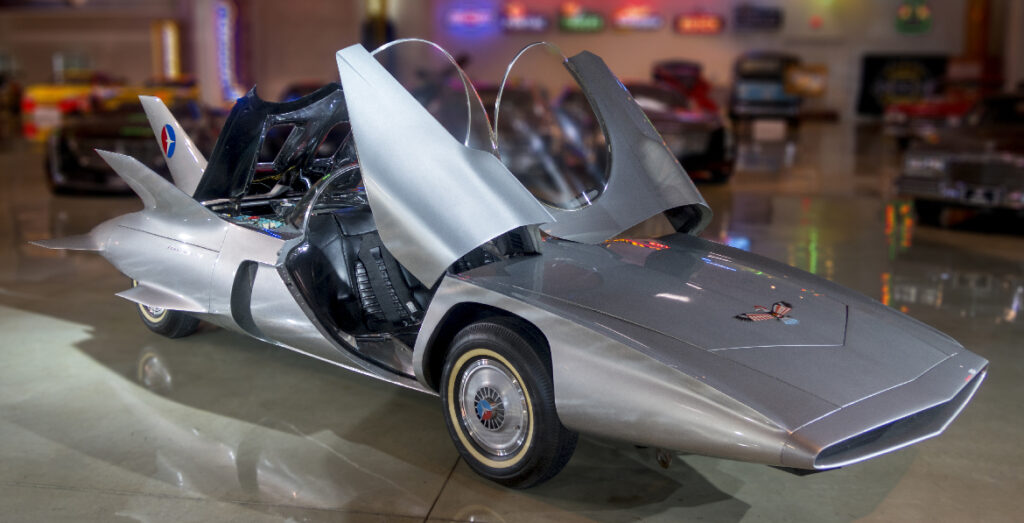
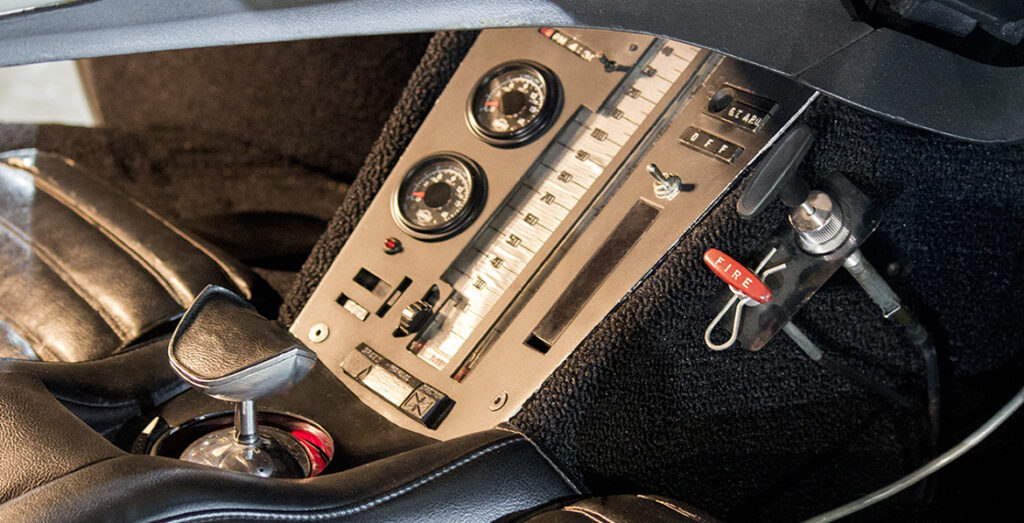
1964 Firebird IV Concept Car
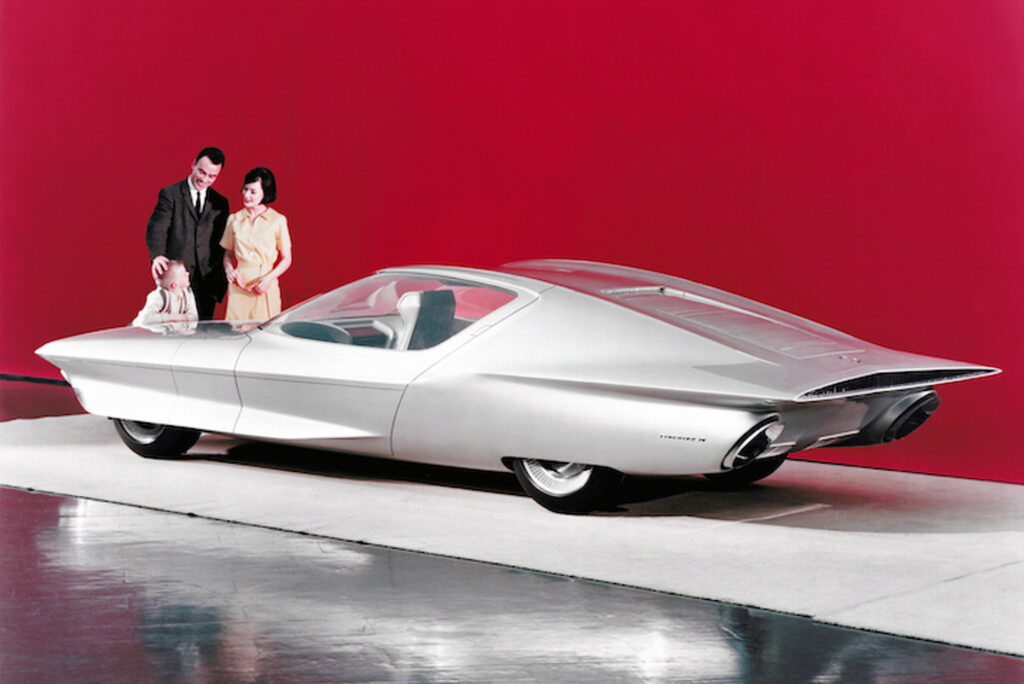
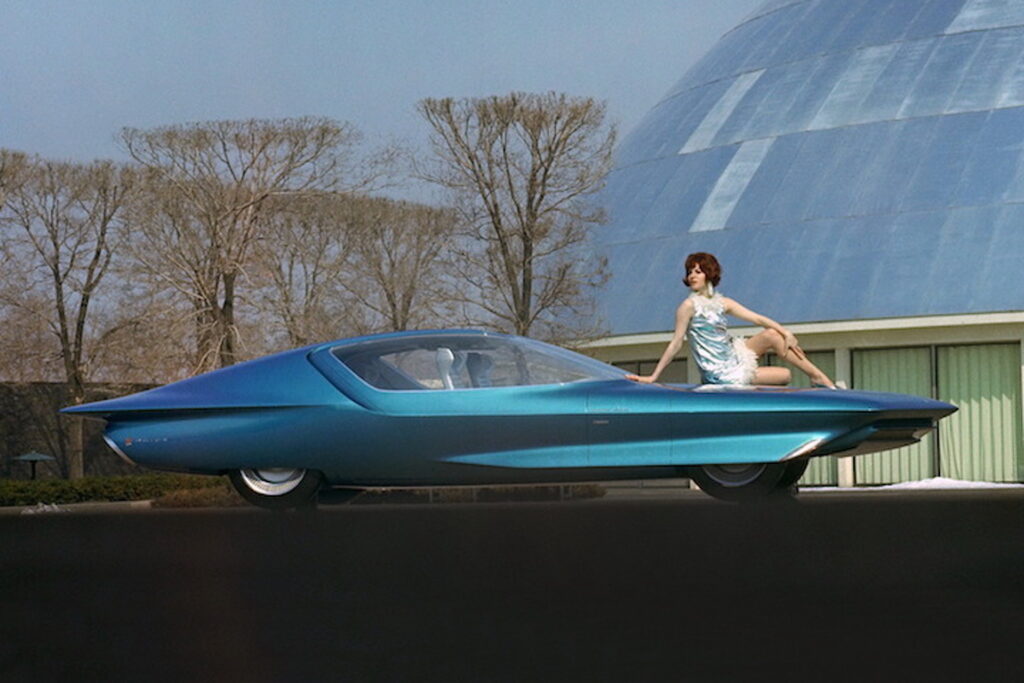
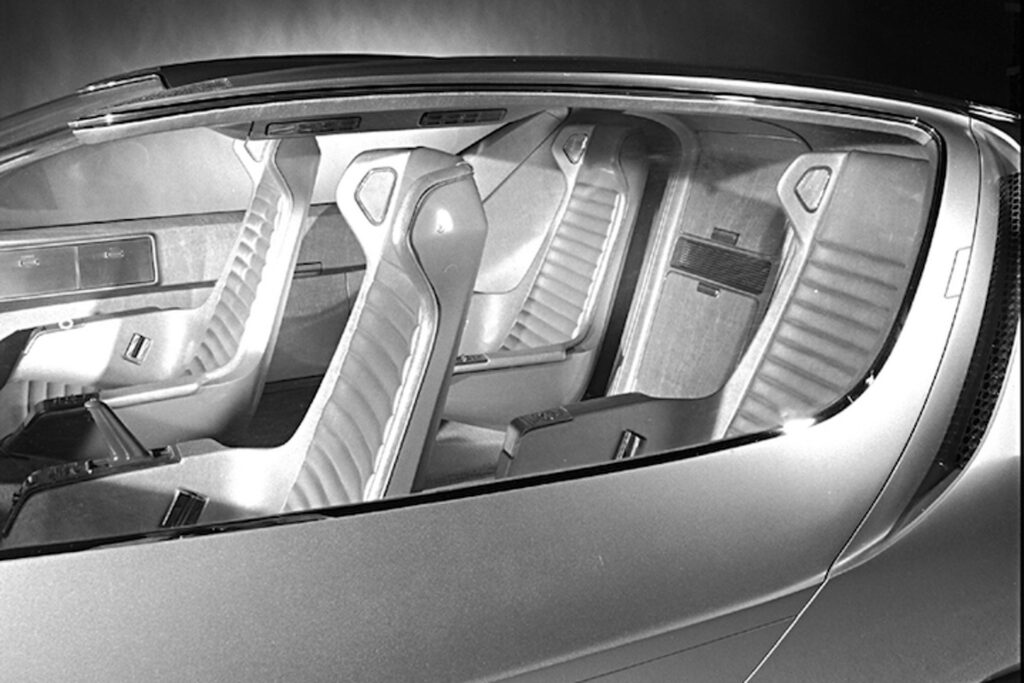
https://www.gmheritagecenter.com/gm-vehicle-collection/1956_Firebird_II.html